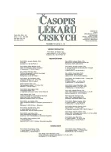Present concept for management of severely injured patients in Trauma Centre Faculty Hospital Královské Vinohrady
Authors:
František Vyhnánek 1; Michal Fric 2; Jaroslav Pažout 2; Petr Waldauf 2; Martin Očadlík 3; Valér Džupa 4
Authors place of work:
Traumatologické centrum FNKV, Praha
1; Klinika anesteziologie a resuscitace 3. LF UK a FNKV, Praha
2; Chirurgická klinika 3. LF UK a FNKV, Praha
3; Ortopedicko-traumatologická klinika 3. LF UK a FNKV, Praha
4
Published in the journal:
Čas. Lék. čes. 2012; 151: 468-471
Category:
Původní práce
Summary
Background.
The implementation of standardized protocols for management of polytrauma, multiple injuries and complicated monotrauma has led to improvement in trauma care with decrease in posttraumatic morbidity and mortality. The introduction of algorithm „Definitive Surgical Trauma Care” (DSTC) with concept of „damage control„ surgery assumed the principal role in care of polytrauma patients. It can be accomplished only in the trauma - centre with implementation of care system for severely injured patients. Analysis of severely injured patients treated in Trauma Centre Faculty Hospital Královské Vinohrady was performed in a retrospective study.
Methods and results.
515 injured patients admitted to emergency unit of the Department of anaesthesiology and resuscitation in years 2009–2010 were evaluated. There were 385 men and 130 women. Average age of patients was 45 years. Primary trauma admissions were 482 (83%) victims. There were 248 (48%) polytrauma patients, 158 (31%) with craniocerebral injuries, 76 (15%) with associated injuries and 33 (6 %) injured with monotrauma. ISS > 16 were in 309 injured patients, average rate ISS was 26.5. Trauma care in emergency unit was provided with the team of specialists (general surgeon for visceral traumatology, orthopaedic surgeon for extremities trauma, specialist for intensive care, anaesthesiology and diagnostic radiology). 412 surgical or radiointervention procedures were performed. There were 313 (76%) urgent surgeries and 99 delayed (24%). The most frequent urgent surgery was for fractures of extremities, (36%) and neurotraumas (29%). Acute operations for thoracic and abdominal trauma were performed in 24% of patients. Delayed surgeries were mostly operations of extremities fractures (66%) and maxillofacial injuries (15%). Mortality was 18% (95 patients); being highest in group of patients with Injury Severity Score (ISS) > 40 (65%).
Conclusions.
The implementation of trauma care system in severely injured patients brings increased numbers of primary trauma admissions to trauma centres. Polytraumas and craniocerebral injuries were the most frequently admitted patients to emergency unit. Implementation of standardized protocols with interdisciplinary cooperation in trauma management represents improvements of trauma care. Early indication and performance of urgent operations with control of bleeding and prevention of subsequent contamination belongs to principal steps in the management of severely injured patients. Definitive management with reoperation in polytrauma patients can be indicated after the stabilisation. ISS > 40 was connected with high mortality rate (65%).
Key words:
definitive surgical trauma care, damage control surgery, trauma care centre for severely injuries.
Zdroje
1. Nast-Kolb D, Ruchholtz S, Waydhas C, Taeger G. Management des Polytraumas. Chirurg 2006; 77(3) : 861–873.
2. Wurmb T, Müller T, Jansen H, el al. Interdisciplinary treatment of severely injuried patients in the trauma resuscitation room. Anasthesiol Intensivmed Notfallmed Schmerzther 2010; 45(6): 390–398.
3. Celso B, Tepas J, Langland-Orban B, et al. A systematic review and meta-analysis comparing outcome of severely injured patients treated in trauma centers following the establishment of trauma systems. J Trauma 2006; 60(2): 371–378.
4. Diggs BS, Mullins RJ, Arthur M, Newgard CD. Proportion of seriously injuried patients admitted to hospitals in the US with a high annual injuried patient volume: a metric of regionalized trauma care. J Am Coll Surg 2008; 206(2): 2120150219.
5. Wurmb T, Frühwald P, Brederlau J, et al. Der Würburger Schockraumalgorithmus. Gesamtkonzept und erste Ergebnisse einer „sliding-gantry-basierten“ Computertomographie-diagnostik. Anaesthesist 2005; 54 : 763–772.
6. Rivara FP, Koepsell TD, Wang L, et al. Outcomes of trauma patients after transfer to a level I trauma center. J Trauma 2008; 64(6): 1594–1599.
7. MacKenzie EJ, Rivara FP, Jurkovich GJ, et al. A national evaluation of the effect of trauma – center on mortality. N Engl J Med 2006; 354(4): 366–378.
8. Cudnik MT, Newgard CD, Sayre MR, Steinberg SM. Level I versus Level II trauma centres: an outcomes-based assessment. J Trauma 2009; 66(5): 1321–1326.
9. Lansink KW, Leenen LP. Do designated trauma systems improve outcome ? Curr Opin Crit Care 2007; 13(6): 686–690.
10. Probst C, Pape HC, Hildebrand F, et al. 30 years of polytrauma care: An analysis of the change in strategies and results of 4849 cases treated at a single institution. Injury 2009; 40(1): 77–83.
11. Newgard CD, McConnell KJ, Hedges JR, Mullins RJ. The bendit of higher level of care transfer of injuried patients from nontertiary hospital emergency departments. J Trauma 2007; 63(5): 965–971.
Štítky
Adiktológia Alergológia a imunológia Angiológia Audiológia a foniatria Biochémia Dermatológia Detská gastroenterológia Detská chirurgia Detská kardiológia Detská neurológia Detská otorinolaryngológia Detská psychiatria Detská reumatológia Diabetológia Farmácia Chirurgia cievna Algeziológia Dentální hygienistkaČlánok vyšiel v časopise
Časopis lékařů českých

- Metamizol jako analgetikum první volby: kdy, pro koho, jak a proč?
- Antidepresivní efekt kombinovaného analgetika tramadolu s paracetamolem
- Kombinace metamizol/paracetamol v léčbě pooperační bolesti u zákroků v rámci jednodenní chirurgie
- Fixní kombinace paracetamol/kodein nabízí synergické analgetické účinky
- Srovnání analgetické účinnosti metamizolu s ibuprofenem po extrakci třetí stoličky
Najčítanejšie v tomto čísle
- Sexuálně přenosné infekce a spermicidy
- XIV. kongres mladých otorinolaryngologů s mezinárodní účastí
- Jak číst kriticky odborné články
- Aktuální koncepce ošetření závažných poranění v Traumatologickém centru Fakultní nemocnice Královské Vinohrady
